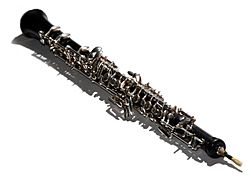Oboe facts for kids

An oboe
|
|
| Woodwind instrument | |
|---|---|
| Classification | |
| Hornbostel–Sachs classification | 422.112-71 (Double-reeded aerophone with keys) |
| Developed | Mid 17th century from the shawm |
| Playing range | |
| Related instruments | |
|
|
The oboe is a woodwind instrument that uses a special double reed. It might look a bit like a clarinet, but there's a big difference! A clarinet is shaped like a straight tube, but an oboe gets wider towards the bottom, like a cone. This shape makes their sounds very different.
To make a sound on the oboe, you blow air through the double reed at the top. This makes the two pieces of reed vibrate together, which creates the sound. An oboe has four main parts: the bell (at the bottom), the lower joint, the upper joint, and the reed. Someone who plays the oboe is called an oboist. In a typical orchestra, you'll usually find two oboes, and sometimes even three! You might also see a cor anglais, which is like a bigger oboe that plays lower notes. Very rarely, you might even spot a bass oboe, which plays even lower. The famous composer Gustav Holst used a bass oboe in his music piece "The Planets."
Contents
What is an Oboe?
The oboe is a woodwind instrument that uses a special double reed to make its sound. It's known for its bright, clear, and sometimes piercing sound. Many people think the oboe has a beautiful, singing tone.
How the Oboe Makes Sound
Unlike some instruments where you just blow air, the oboe needs a double reed. This means two small pieces of cane are tied together. When you blow air between these two reeds, they vibrate very quickly against each other. These vibrations then travel through the instrument's body, creating the musical sound you hear.
Parts of the Oboe
An oboe is made up of several parts that fit together:
- The Reed: This is the most important part for making sound. It's usually made from a type of cane.
- The Upper Joint: This is the top part of the oboe, where the reed is attached. It has many keys and holes.
- The Lower Joint: This is the middle part of the oboe, also with keys and holes.
- The Bell: This is the flared, cone-shaped end at the bottom of the instrument. It helps the sound project.
History of the Oboe
The oboe came from an older instrument called the shawm. The shawm was popular in the Middle Ages and the Renaissance. The oboe itself became very popular during the Baroque period (around the 1600s and 1700s).
Baroque Oboe Music
Many famous composers from the Baroque period loved the oboe. Bach and Handel used it in most of their orchestral music. Italian composers like Antonio Vivaldi even wrote special concertos just for the oboe. It was also used a lot in chamber music, which is music for a small group of instruments. Back then, oboes didn't have many keys. But over time, more keys were added, which made it much easier to play different notes, especially sharps and flats.
Later Oboe Music
After the Baroque period, other famous composers continued to write beautiful music for the oboe as a solo instrument. These include Mozart, Weber, Richard Strauss, Vaughan Williams, and Francis Poulenc.
The Tuning A
In an orchestra, before they start playing, all the musicians need to make sure their instruments are in tune with each other. It's a tradition that the main oboist plays the note "A" (A440). All the other musicians then adjust their instruments to match that "A" sound. This helps everyone play together perfectly!
Where the Name "Oboe" Comes From
The word "oboe" actually comes from the French language word hautbois. This word means "high wood" or "high-pitched woodwind instrument." It's a perfect name for this instrument, given its clear, high sound!
More Oboe Pictures
-
The members of the oboe family from top: heckelphone, bass oboe, cor anglais, oboe d'amore, oboe, and piccolo oboe
See also
 In Spanish: Oboe para niños
In Spanish: Oboe para niños







